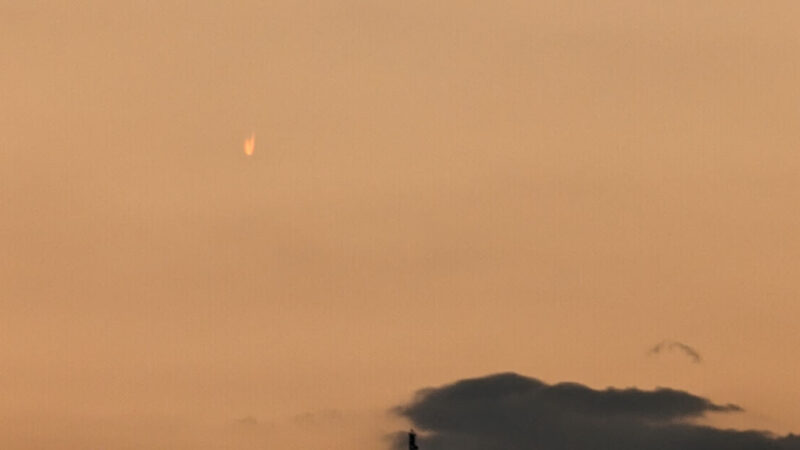Last Wednesday evening, returning home from work, I stopped by the sea to enjoy the landscape and more, as I do almost daily.
The sun had just set and I was enjoying the sky’s colors when I suddenly noticed a strange light in the sky.
Well, check it out:
I filmed it too (with my phone, so excuse the poor quality):
I’m trying to figure out what it was, but I really have no clue.
My first reaction was to pull out a “sky map” application and check what was supposed to be there and the most likely culprit is Mars who is closely following the Sun at the moment.
It does look bigger than Mars, but as you may know, planets and such look bigger when they rise or set (see the Moon) because of some optical distortion (basically a magnifying glass effect.) So, sure, Mars, why not?
But what is that sort of tail then? As far as I know, there is no comet visible to the naked eye these days. I wish there were, I think I was in my early 20s the last time (the only time) I saw one.
A meteor? No. You’ve all seen shooting stars before, right? That thing was mostly stable in the sky. Sure, it was slowly falling, but not faster than the sun or a planet would set behind the horizon.
So Mars it is, isn’t it?
What about that tail? Could it be a satellite re-entering the atmosphere but taking a long time to do so? Maybe not one just burning, but a controlled re-entry? No clue.
So, yes, if you’re into astronomy and have a clue of what this could be (and if this is Mars, what is that tail thing?) please tell me, because I’m greatly confused and I really want to know.
Thanks in advance.
Update: Alan Versfeld wrote this on Mastodon
I don’t know what it is, but I can make a few guesses and eliminate a few possibilities.
So first, It’s not Mars. When objects are low on the horizon like that, their colour shifts red and they twinkle more aggressively. Their shape also distorts, and flattens, which you can see on the Sun and Moon, but isn’t obvious on small things) but they don’t actually magnify (that’s an optical illusion, not a real optical effect.) Besides, anything that close to the horizon appears fainter, not brighter, and your object is a pretty bright white.
As for comets, you’re right. There are no naked eye comets in the sky at the moment.
So I don’t think this is an astronomical object.
So I’m thinking either a recently launched rocket or satellite dumped fuel a while ago, and it seems mostly stationary simply because it being low on the horizon means that it’s motion could be directly towards or away from you), or maybe something closer by in the atmosphere. Perhaps a forehortened contrail? Maybe, and I know this is a bit of a stretch, a weather balloon that’s high enough that it’s still in direct sunlight (that could maybe also explain the wedge V-shape, if it’s lit from beneath).
Anyway, I’m not very confident about any of those guesses, but they don’t seem crazy unlikely either 🙂
I don’t know what it is, but I can make a few guesses and eliminate a few possibilities.
So first, It’s not Mars. When objects are low on the horizon like that, their colour shifts red and they twinkle more aggressively. Their shape also distorts, and flattens, which you can see on the Sun and Moon, but isn’t obvious on small things) but they don’t actually magnify (that’s an optical illusion, not a real optical effect.) Besides, anything that close to the horizon appears fainter, not brighter, and your object is a pretty bright white.
As for comets, you’re right. There are no naked eye comets in the sky at the moment.
So I don’t think this is an astronomical object.
So I’m thinking either a recently launched rocket or satellite dumped fuel a while ago, and it seems mostly stationary simply because it being low on the horizon means that it’s motion could be directly towards or away from you), or maybe something closer by in the atmosphere. Perhaps a forehortened contrail? Maybe, and I know this is a bit of a stretch, a weather balloon that’s high enough that it’s still in direct sunlight (that could maybe also explain the wedge V-shape, if it’s lit from beneath).
Anyway, I’m not very confident about any of those guesses, but they don’t seem crazy unlikely either 🙂
Thank you, Alan.
Update November 3rd.
Two days ago, around the same time (5h40 p.m.) it was almost nighttime (days are getting shorter) and I saw a plane pretty much at the same spot. The plane was approaching the city’s airport, and that confused me at first. Planes usually approach the airport from the east, not from the west, like this plane was doing. Then I realized that at this time of the day, the pilot would have the sun in their eyes if they approached from the east as usual.
Mystery solved?
Probably.


